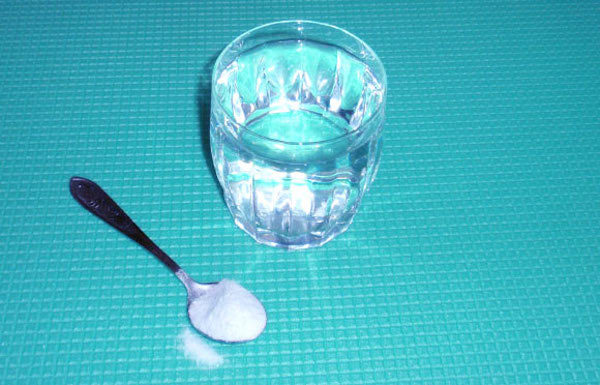
"'It's most likely a hamburger not a bacterial infection,' is basically the message," said study senior author Dr. Paul O'Connor, from the Department of Physiology at Augusta University.
Mesothelial cells line body cavities, like the one that contains our digestive tract, and they also cover the exterior of our organs to quite literally keep them from rubbing together.
About a decade ago, it was found that these cells also provide another level of protection. They have little fingers - called microvilli - that sense the environment, and warn the organs they cover that there is an invader and an immune response is needed.
Drinking baking soda tells the spleen - which is part of the immune system, acts like a big blood filter and is where some white blood cells, like macrophages, are stored - to go easy on the immune response.
"Certainly drinking bicarbonate affects the spleen and we think it's through the mesothelial cells," Dr. O'Connor said.
"The conversation, which occurs with the help of the chemical messenger acetylcholine, appears to promote a landscape that shifts against inflammation."
In the spleen, as well as the blood and kidneys, the scientists found after drinking water with baking soda for two weeks, the population of immune cells called macrophages, shifted from primarily those that promote inflammation, called M1, to those that reduce it, called M2.
Macrophages, perhaps best known for their ability to consume garbage in the body like debris from injured or dead cells, are early arrivers to a call for an immune response.
In the case of the lab animals, the problems were hypertension and chronic kidney disease, problems which got the researchers thinking about baking soda.
"One of the many functions of the kidneys is balancing important compounds like acid, potassium and sodium," Dr. O'Connor said.
"With kidney disease, there is impaired kidney function and one of the resulting problems can be that the blood becomes too acidic. Significant consequences can include increased risk of cardiovascular disease and osteoporosis."
"It sets the whole system up to fail basically. Clinical trials have shown that a daily dose of baking soda can not only reduce acidity but actually slow progression of the kidney disease, and it's now a therapy offered to patients."
"We started thinking, how does baking soda slow progression of kidney disease?"
That's when the anti-inflammatory impact began to unfold as the team saw reduced numbers of M1s and increased M2s in their kidney disease model after consuming the common compound.
When they looked at a rat model without actual kidney damage, they saw the same response. Healthy medical students who drank baking soda in a bottle of water also had a similar response.
"The shift from inflammatory to an anti-inflammatory profile is happening everywhere. We saw it in the kidneys, we saw it in the spleen, now we see it in the peripheral blood," Dr. O'Connor said.
"The shifting landscape is likely due to increased conversion of some of the proinflammatory cells to anti-inflammatory ones coupled with actual production of more anti-inflammatory macrophages."
The study authors also saw a shift in other immune cell types, like more regulatory T cells, which generally drive down the immune response and help keep the immune system from attacking our own tissues. That anti-inflammatory shift was sustained for at least four hours in humans and three days in rats.
The shift ties back to the mesothelial cells and their conversations with our spleen with the help of acetylcholine. Part of the new information about mesothelial cells is that they are neuron-like, but not neurons.
"We think the cholinergic (acetylcholine) signals that we know mediate this anti-inflammatory response aren't coming directly from the vagal nerve innervating the spleen, but from the mesothelial cells that form these connections to the spleen," Dr. O'Connor said.
"In fact, when they cut the vagal nerve, a big cranial nerve that starts in the brain and reaches into the heart, lungs and gut to help control things like a constant heart rate and food digestion, it did not impact the mesothelial cells' neuron-like behavior."
"The affect, it appears, was more local because just touching the spleen did have an effect."
"When we removed or even just moved the spleen, it broke the fragile mesothelial connections and the anti-inflammatory response was lost," Dr. O'Connor said.
"In fact, when we only slightly moved the spleen as might occur in surgery, the previously smooth covering of mesothelial cells became lumpier and changed colors. We think this helps explain the cholinergic (acetylcholine) anti-inflammatory response that people have been studying for a long time."
Source
Sarah C. Ray et al. Oral NaHCO3 Activates a Splenic Anti-Inflammatory Pathway: Evidence That Cholinergic Signals Are Transmitted via Mesothelial Cells. J. Immunol, published online April 16, 2018; doi: 10.4049/jimmunol.1701605



acetylcholine? a connection to tobacco/nicotine?
Vagus Nerve Controls Intestinal Inflammation
Macrophages release inflammatory signals (TNF, IL-1, IL-6, IL-18) that result in tissue inflammation. Nicotine is anti-inflammatory by acting on the acetylcholine receptors normally responsive to...